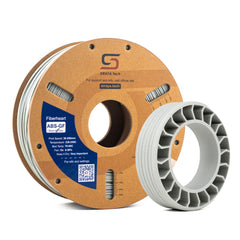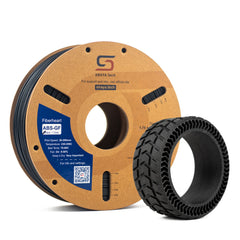Fibreheart ABS-GFフィラメントユーザーガイド
1. ファイバーハートABS-GFの紹介
愛好家や専門家向けに設計されたこのガイドは、ABS の堅牢性と耐熱性を、ガラス繊維注入による印刷の容易さと反りの低減と融合させ、ABS-GF の可能性を最大限に引き出します。
10%のガラス含有量と滑らかな印刷体験を実現し、最高のABS性能が求められる用途に最適です。ファイバーハートABS-GFは、臭いを最小限に抑え、ひび割れを軽減することで印刷精度を向上させます。


2. 印刷の準備
(1)プリンターの互換性
Fibreheart ABS-GFは、ツールヘッド上にダイレクトドライブエクストルーダーを搭載したFDMプリンター向けに最適化されており、フィラメント制御を強化しています。このセットアップは、ABS-GFプリントの成功に不可欠です。
(2)プリントベッドの準備
清潔で水平なプリントベッドが不可欠です。プリンターの性能に合わせて、100℃~110℃の範囲で加熱ベッドの温度を調整することをお勧めします。
(3)同封物
エンクロージャは、理想的には約 50°C の一定の印刷温度を維持し、特に寒冷気候での反りや故障率などの問題を大幅に削減するために不可欠です。
3. 材料特性
密度: 1.08 g/cm³ (ISO 1183)
硬度:82D
溶融温度:250℃
軟化温度:106℃(ISO 306)
以下の数値はすべてX/Y軸でテストされています
引張破断強度:44±3.0 MPa(ISO 527)
破断伸び: 3%
4. ファイバーハートABS-GFで印刷
(1)温度設定
理想的な押し出しノズルの温度は 250°C ~ 270°C の範囲ですが、プリンターのモデルや環境要因によって異なります。
(2) 印刷速度
Fibreheart ABS-GFは高流動性樹脂のため、30~120mm/秒の速度でプリントできます。最初は低速から始め、徐々に速度を上げていくことで最適な結果が得られます。
(3)ノズル
Fibreheart ABS-GFの印刷には、ガラス繊維の摩耗性に耐えるため、硬化鋼またはダイヤモンドチップのノズルを使用してください。0.2mm以上のノズルでも使用できますが、0.4mmのノズルを使用すると最良の結果が得られることが多く、長期的な印刷の一貫性と品質が保証されます。
(4) 撤回設定
目詰まりを防ぐため、引き込み速度は1800~3600mm/分、引き込み距離は1~5mmに抑えてください。最初は短くゆっくりとした引き込みから始めてください。
(5)プラットフォーム材料の構築
最良の接着性を得るには、PEI またはガラスにグルースティックを塗布することをお勧めします。
(6) 冷却ファン
冷却ファンが動作していることを確認してください。ただし、印刷品質を維持するために低速で運転してください。通常、ファンの回転速度は0~30%で印刷されます。お使いのプリンターに合わせて設定を調整してください。
5. 水分管理
 Fibreheart ABS-GFを含むABSフィラメントは吸湿性が高く、印刷品質に悪影響を与える可能性があります。そのため、効果的な水分管理が不可欠です。
Fibreheart ABS-GFを含むABSフィラメントは吸湿性が高く、印刷品質に悪影響を与える可能性があります。そのため、効果的な水分管理が不可欠です。
(1)保管方法:ファイバーハートABS-GFは、使用しない時は付属の防湿アルミ袋に入れて保管してください。乾燥剤を入れたドライボックスを使用し、湿度を15%以下に保って長期保管してください。
(2)フィラメントの乾燥:吸湿が疑われる場合は、フィラメント乾燥機またはオーブンで65℃、4~6時間でフィラメントを乾燥させます。
6. よくある問題のトラブルシューティング
(1) 糸引き:糸引きに対処するには、リトラクション設定と印刷速度を調整してください。また、フィラメントの水分レベルが許容範囲内であることを確認してください。
(2) ベッドの接着不良:スティックのりやヘアスプレーを使用するか、ベッド温度を少し上げることで、ベッドの接着力を改善できます。温度は100℃以上に設定し、囲いを設けることで接着力を大幅に向上させることができます。
